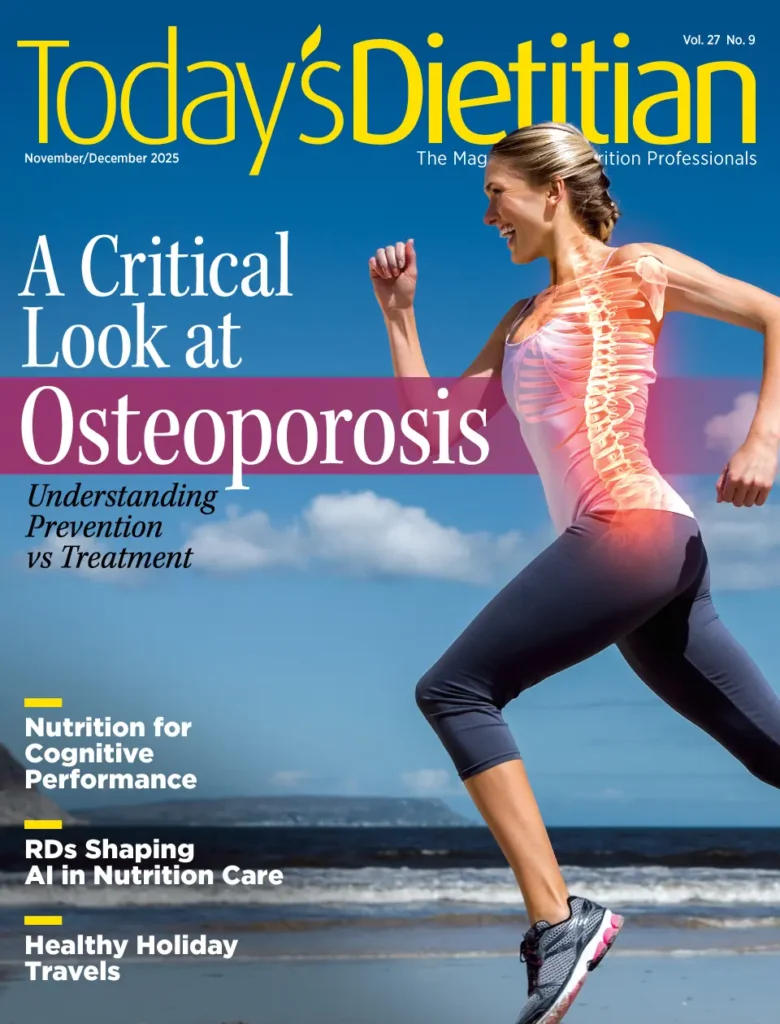Today’s Dietitian
Vol. 27 No. 9 P. 6
Q: I have been hearing a lot about maltodextrin and its use as an additive in processed food and beverages. Is it safe to consume?
A: Maltodextrin is a type of carbohydrate that undergoes processing to an end product that is a water-soluble white powder with a neutral taste. It is used as an additive in many processed foods in order to improve texture, shelf life, and taste, and even replace sugar. Below you will find an overview of how maltodextrin is processed, its uses, and health concerns about its use as an additive.
Processing of Maltodextrin
Maltodextrin is a polysaccharide typically formed by enzymatic partial hydrolysis of starches like corn or wheat. After hydrolysis, they are purified and spray dried.1 The result is a microbiologically safe, commercially available white powder of high purity. Maltodextrin is generally regarded as safe (GRAS) by the FDA.2 It has many uses in food and beverage products including acting as an anticaking agent, flavoring agent, humectant (preserves moisture), nutrient supplement, nutritive sweetener, solvent, stabilizer (thickener), surfactant (reduces the surface tension of a liquid, enabling it to spread more easily), and texturizer (enhances sensory appeal). Maltodextrin can be used in food and drink products like protein powder, baked goods, frozen desserts, instant pudding, soups, food seasonings, sports drinks, cereals, artificial sweeteners, chips, sauces, yogurt, beer, candy, and soft drinks.2
Different types of maltodextrin can be used, including digestible and indigestible versions. The indigestible maltodextrin can be used as dietary fiber or a prebiotic; however, the information and research shared below pertains to the digestible form.1
Impact on the Gut Microbiome
Glucose from digested maltodextrin is rapidly absorbed in the small intestine and considered a good source of energy. Its increased use in food and beverages has raised concern about its potential effects on intestinal homeostasis.
A 2018 published study examined the effect of maltodextrin on gut inflammation in mice. Researchers found that consumption of maltodextrin exacerbated intestinal inflammation in a dose-dependent manner.3,4Authors of a published editorial on this study concluded that maltodextrin detrimentally impacted the intestinal environment by promoting depletion of the protective mucus layer and fostering the development of intestinal inflammation.4
A 2022 published study examined the mechanism by which maltodextrin alters the development of colitis. Mice were fed diets supplemented with maltodextrin or carboxymethyl cellulose to determine their impact on colitis onset and severity. Based on the results, researchers concluded that maltodextrin disrupts the balance of epithelial cell differentiation and proliferation which may contribute to disease pathogenesis through direct and indirect actions on the intestinal epithelial barrier.5
Additional Concerns
Although no causal relationship between consumption of maltodextrin and negative health effects in humans has been reported to date, there is a lack of research on what might happen if maltodextrin is overconsumed. Some other concerns about the use of maltodextrin include its potential role in weight gain, impact on those with diabetes, and whether it’s safe for individuals with gluten allergy or celiac disease.
Maltodextrin is more commonly found in some heavily processed foods, which may already carry additional concerns. Overconsumption of highly processed foods that are high in added sugar and refined carbohydrates—specifically soft drinks, sweet snacks, or candy—can lead to weight gain and other health risks. The glycemic index of maltodextrin is higher than table sugar with a score of 95 and 65, respectively. This can be a particular concern for people living with prediabetes or diabetes.1
Some worry that maltodextrin from wheat could be detrimental for people with celiac disease. According to the Celiac Disease Foundation, there is confusion between the uses of “wheat starch” vs “derived from a wheat source” on labels. People with celiac disease must avoid foods with wheat starch. However, if the label lists “derived from a wheat source,” it typically refers to one of the sugar alcohols (eg, polyols) or wheat maltodextrin. Since these are highly processed sugars that contain no wheat gluten, the Celiac Disease Foundation says they won’t cause a reaction.6
Recommendations for Dietitians
Maltodextrin is considered GRAS by the FDA; however, some concerns have been raised on various health fronts. Since initial studies have only been conducted on rodents, more research is needed to make stronger direct health links at this time. Maltodextrin may be found in both nutrient-dense and less healthy foods. RDs can recommend limiting those less healthy foods like candy and soft drinks. If a client is worried about maltodextrin, RDs can share information on the current state of research, guide them on how to identify and read food label ingredients, and recommend brands of nutrient-dense foods that don’t use maltodextrin.
— Toby Amidor, MS, RD, CDN, FAND, is founder of Toby Amidor Nutrition (tobyamidornutrition.com) and a Wall Street Journal bestselling author. She’s written 11 cookbooks, including her latest, Health Shots: 50 Simple Tonics to Help Improve Immunity, Ease Anxiety, Boost Energy, and More (November 2024). She’s also an award-winning media dietitian, spokesperson, and nutrition expert for FoodNetwork.com and a contributor to U.S. News and other national outlets.
References
1. Hofman DL, van Buul VJ, Brouns FJPH. Nutrition, health, and regulatory aspects of digestible maltodextrins. Crit Rev Food Sci Nutr. 2016;56(12):2091-2100.
2. Substances added to food: maltodextrin. US Food & Drug Administration website. https://www.hfpappexternal.fda.gov/scripts/fdcc/index.cfm?set=FoodSubstances&id=MALTODEXTRIN. Accessed July 29, 2025.
3. Laudisi F, Di Fusco D, Dinallo V, et al. The food additive maltodextrin promotes endoplasmic reticulum stress-driven mucus depletion and exacerbates intestinal inflammation. Cell Mol Gastroenterol Hepatol. 2019;7(2):457-473.
4. Arnold AR, Chassaing B. Maltodextrin, modern stressor of the intestinal environment. Cell Mol Gastroenterol Hepatol. 2019;7(2):475-476.
5. Zangara MT, Ponti AK, Miller ND, et al. Maltodextrin consumption impairs the intestinal mucus barrier and accelerates colitis through direct actions on the epithelium. Front Immunol. 2022;13:841188.
6. Gluten in medicine, vitamins & supplements. Celiac Disease Foundation website. https://celiac.org/gluten-free-living/gluten-in-medicine-vitamins-and-supplements/. Accessed July 29, 2025.



